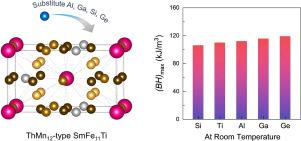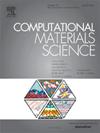Enhancing intrinsic magnetic properties and phase stability in SmFe11Ti through elemental substitution: A first-principles approach
IF 3.3
3区 材料科学
Q2 MATERIALS SCIENCE, MULTIDISCIPLINARY
引用次数: 0
Abstract
ThMn12-type SmFe11Ti has been identified as a structurally stable phase in its bulk form; however, the presence of Ti markedly suppresses its intrinsic magnetic performance. Herein, we employ density functional theory and Monte Carlo simulations to investigate partial substitution of Ti with simple metal and metalloid elements as a strategy to enhance intrinsic magnetic properties without compromising structural stability. Our results reveal that Al substitution is particularly effective, with SmFe11Al0.5Ti0.5 achieving a saturation magnetization of 0.97 T and a magnetocrystalline anisotropy of 6.3 MJ/m3 at room temperature. These values lead to substantial improvements in the theoretical maximum energy product, anisotropic field, and hardness parameter, exceeding those of conventional SmFe11Ti. The enhancements are attributed to modifications in the electronic energy levels of the strongly spin–orbit coupled Sm orbitals upon elemental substitution. These findings provide a promising pathway for developing high-performance permanent magnets with reduced rare-earth content, supporting sustainable advanced permanent magnetic materials.

通过元素取代增强SmFe11Ti的本征磁性能和相稳定性:第一性原理方法
thmn12型SmFe11Ti已被确定为结构稳定相;然而,钛的存在明显抑制了其固有磁性能。在此,我们采用密度泛函理论和蒙特卡罗模拟来研究用简单金属和类金属元素部分取代Ti作为在不影响结构稳定性的情况下提高固有磁性能的策略。我们的研究结果表明,Al取代特别有效,SmFe11Al0.5Ti0.5在室温下达到0.97 T的饱和磁化强度和6.3 MJ/m3的磁晶各向异性。这些值导致理论最大能积、各向异性场和硬度参数的显著改善,超过了传统的SmFe11Ti。这种增强是由于元素取代后,强自旋轨道耦合的sm4f轨道的电子能级发生了变化。这些发现为开发低稀土含量的高性能永磁体提供了一条有希望的途径,支持可持续的先进永磁材料。
本文章由计算机程序翻译,如有差异,请以英文原文为准。
求助全文
约1分钟内获得全文
求助全文
来源期刊

Computational Materials Science
工程技术-材料科学:综合
CiteScore
6.50
自引率
6.10%
发文量
665
审稿时长
26 days
期刊介绍:
The goal of Computational Materials Science is to report on results that provide new or unique insights into, or significantly expand our understanding of, the properties of materials or phenomena associated with their design, synthesis, processing, characterization, and utilization. To be relevant to the journal, the results should be applied or applicable to specific material systems that are discussed within the submission.
 求助内容:
求助内容: 应助结果提醒方式:
应助结果提醒方式:


